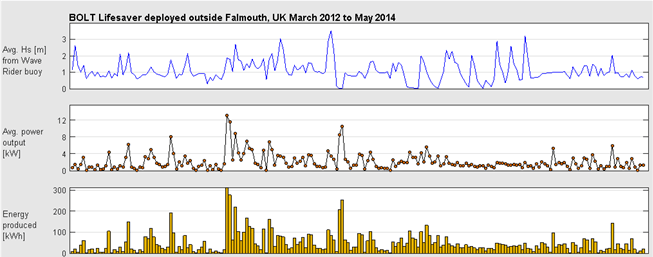BOLT Lifesaver at UK Government Test Site Falmouth (2012-2014)
In 2010, Fred.Olsen, along with partners Supacat, Scotrenewables, A&P, Falmouth Harbour Commissioners and the University of Exeter, was awarded funding from the UK Governmental body Technology Strategy Board to design, build and deploy the BOLT Lifesaver wave energy converter.
BOLT Lifesaver was designed and built 2010-2012 and installed at the FabTest test site off the coast of Falmouth, UK in March 2012.
Fully electric and with a brand new high cycle PTO winch design, she was deployed for 28 months and decommissioned from the site June 2014. Key performance indicators to date in table below.
| Operational Key Performance Indicators | |
| Period installed on site | March 2012 – May 2014 |
| Time on site | 18 984 hrs |
| Production conditions (Hs>0.5m) | 6 114 hrs |
| Production hours | 4 267 hrs |
| Production availability* | 70% |
| Uptime** | 23% |
| Total produced electrical energy | 9 401 kWh |
| Total absorbed mechanical energy | 18 700 kWh |
| Overall efficiency (electrical/mechanical energy) | 50.3% |
| Average power over all production periods | 2.2 kW |
| Max average power over 20 min series | 22 kW |
| Lower sea state for net positive power production | Ca. Hs=0.5 m |
| Highest significant wave height during production | Hs=3.69 m |
| Longest recorded single winch stroke | 10.0m |
* Total production hours divided by total hours of production conditions (Hs>0.5m).
** Total production hours divided by total hours on site.
The BOLT Lifesaver PTOs operate individually, meaning a failure of one PTO does not affect performance of the others. Hence, during much of the operation at FabTest only one or two PTOs were engaged in the energy production.





